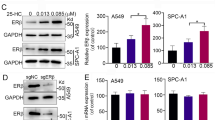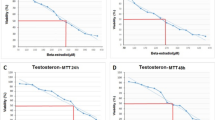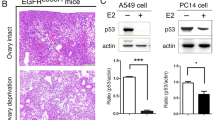Abstract
Metastasis remains one of the major challenges before hepatocellular carcinoma (HCC) is finally conquered. Estrogen has recently emerged as a protective factor in the development and progression of HCC, but whether and how it reduces metastasis of HCC remain to be elucidated. We conducted an in vivo highly metastatic rat HCC model in female Sprague–Dawley rats induced by diethylnitrosamine and N-nitrosomorpholine to examine the effects of estrogen on HCC metastasis. Moreover, female rats were randomly distributed into four groups: ovariectomy (OVX), sham operation, ovariectomy followed by 30 μg/kg body weight/day 17α-ethynylestradiol supplementation, and sexually intact control groups. Here, we show that, 60% lung metastasis was observed in the rats of OVX group, whereas 17–25% lung metastasis was found in rats of the other three groups. Furthermore, physiological doses of estrogen, no matter endogenous or exogenous, can suppress metastasis of HCC through decreasing interleukin-6 (IL-6) and hepatocyte growth factor (HGF) expression in the tumor microenvironment. In conclusion, the present study demonstrated that estrogen has the potential to inhibit lung metastasis from rat HCCs in vivo. Its mechanism of action may involve modulation of inflammatory tumor microenvironment by suppression of HGF and IL-6 production.





Similar content being viewed by others
REFERENCES
El-Serag, H.B., and K.L. Rudolph. 2007. Hepatocellular carcinoma: Epidemiology and molecular carcinogenesis. Gastroenterology 132: 2557–2576.
Naugler, W.E., T. Sakurai, S. Kim, S. Maeda, K. Kim, A.M. Elsharkawy, et al. 2007. Gender disparity in liver cancer due to sex differences in MyD88-dependent IL-6 production. Science 317: 121–124.
Shimizu, I., M. Yasuda, Y. Mizobuchi, Y.R. Ma, F. Liu, M. Shiba, et al. 1998. Suppressive effect of oestradiol on chemical hepatocarcinogenesis in rats. Gut 42: 112–119.
Coussens, L.M., and Z. Werb. 2002. Inflammation and cancer. Nature 420: 860–867.
Karin, M. 2006. Nuclear factor-kappaB in cancer development and progression. Nature 441: 431–436.
Wang, W., W.D. Jia, G.L. Xu, Z.H. Wang, J.S. Li, J.L. Ma, et al. 2009. Antitumoral activity of rapamycin mediated through inhibition of HIF-1alpha and VEGF in hepatocellular carcinoma. Digestive Diseases and Sciences 54: 2128–2136.
Ke, H.Z., H.K. Chen, H.A. Simmons, H. Qi, D.T. Crawford, C.M. Pirie, et al. 1997. Comparative effects of droloxifene, tamoxifen, and estrogen on bone, serum cholesterol, and uterine histology in the ovariectomized rat model. Bone 20: 31–39.
Moon, W.S., K. Chang, and A.S. Tarnawski. 2004. Overexpression of metastatic tumor antigen 1 in hepatocellular carcinoma: Relationship to vascular invasion and estrogen receptor-alpha. Human Pathology 35: 424–429.
Soresi, M., L. Giannitrapani, F. D’Antona, A.M. Florena, E. La Spada, A. Terranova, et al. 2006. Interleukin-6 and its soluble receptor in patients with liver cirrhosis and hepatocellular carcinoma. World Journal of Gastroenterology 12: 2563–2568.
Yamaguchi, Y. 2007. Microenvironmental regulation of estrogen signals in breast cancer. Breast Cancer 14: 175–181.
Porter, L.E., M.S. Elm, D.H. Van Thiel, M.C. Dugas, and P.K. Eagon. 1983. Characterization and quantitation of human hepatic estrogen receptor. Gastroenterology 84: 704–712.
Eagon, P.K., S.E. Fisher, A.F. Imhoff, L.E. Porter, R.R. Stewart, D.H. Van Thiel, et al. 1980. Estrogen-binding proteins of male rat liver: Influences of hormonal changes. Archives of Biochemistry and Biophysics 201: 486–499.
Shimizu, I., and S. Ito. 2007. Protection of estrogens against the progression of chronic liver disease. Hepatology Research 37: 239–247.
Itagaki, T., I. Shimizu, X. Cheng, Y. Yuan, A. Oshio, K. Tamaki, et al. 2005. Opposing effects of oestradiol and progesterone on intracellular pathways and activation processes in the oxidative stress induced activation of cultured rat hepatic stellate cells. Gut 54: 1782–1789.
ACKNOWLEDGMENTS
We show thanks for all the clinicians and researchers who are involved in this study. This study was supported by the National Natural Science Foundation of China (30972893) and the Anhui Provincial “115” Industrial Innovation Program.
Author information
Authors and Affiliations
Corresponding author
Rights and permissions
About this article
Cite this article
Wang, YC., Xu, GL., Jia, WD. et al. Estrogen Suppresses Metastasis in Rat Hepatocellular Carcinoma through Decreasing Interleukin-6 and Hepatocyte Growth Factor Expression. Inflammation 35, 143–149 (2012). https://doi.org/10.1007/s10753-011-9299-3
Published:
Issue Date:
DOI: https://doi.org/10.1007/s10753-011-9299-3




